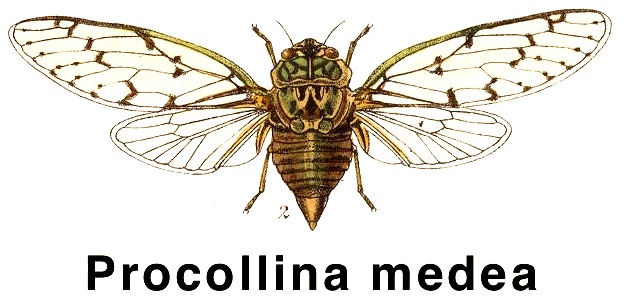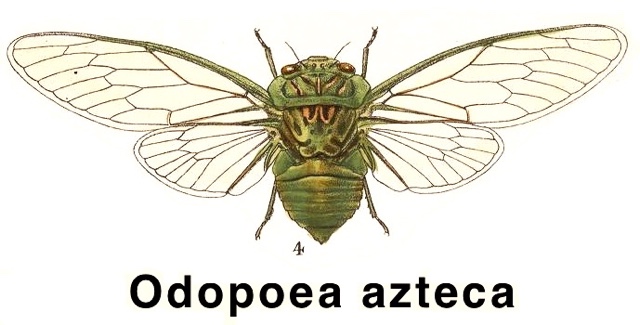A pair of Zammara smaragdina from the collection of Richard Newfrock.
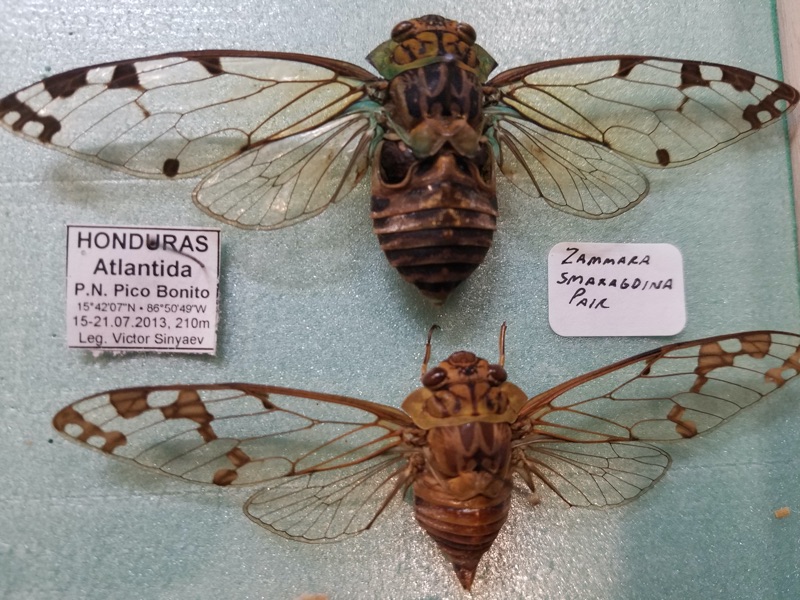
A pair of Zammara smaragdina from the collection of Richard Newfrock.

Odopoea signoreti Stål, 1864 is a cicada found in Mexico.
Scientific classification:
Family: Cicadidae
Subfamily: Cicadinae
Tribe: Zammarini
Genus: Odopoea
Species: Odopoea signoreti Stål, 1864
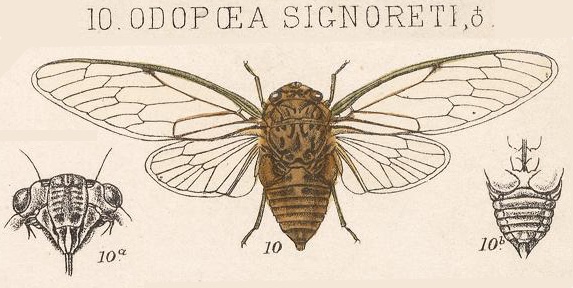
Odopoea diriangani Distant, 1881, is a cicada found in Nicaragua.
Scientific classification:
Family: Cicadidae
Subfamily: Cicadinae
Tribe: Zammarini
Genus: Odopoea
Species: Odopoea diriangani Distant, 1881
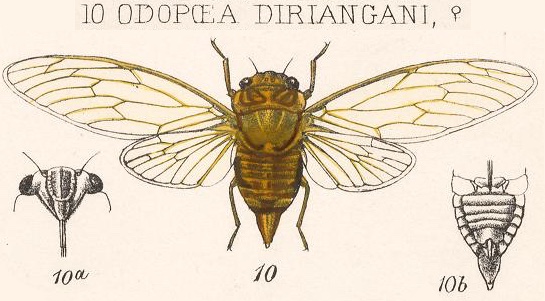
Odopoea diriangani species description by W. L. Distant:
Ochraceous and unicolorous, obscurely pilose. Tegmina and wings hyaline, veins ochraceous. Face strongly carinate, its width and distance to outer margin of eyes being subequal. Eyes black, ocelli red. Pronotum with the lateral margins considerably ampliated and rounded, obtusely and obscurely angulated about middle. Mesonotum with two large but obscure obconical spots commencing on apical margin. Anterior femora with a strong spine about one third from apex, between which and apex are two smaller and much more obscure spines.
Long. 22 millim., exp. tegm. 69 millim.
This species is allied to O. signoreti, Stal, and 0. azteca, Dist., from both of which it differs by the neuration of the tegmina being unicolorous, by the basal margin of the eighth apical area being almost straight and oblique, the ulnar veins abruptly divergent at base, and also by the strongly carinate face. It is more than probable that some specimens of this species are green, and not ochraceous like the form here described.
Zammara brevis (Distant, 1905) is a cicada found in Columbia.
It was formerly known as Orellana brevis, as you can see from the image below. The Zammara and Orellana genera are very similar — both belong to the tribe Zammarini, both share pronounced pronotal collars and often green coloring.
Scientific classification:
Family: Cicadidae
Subfamily: Cicadinae
Tribe: Zammarini
Genus: Zammara
Species: Zammara brevis (Distant, 1905)
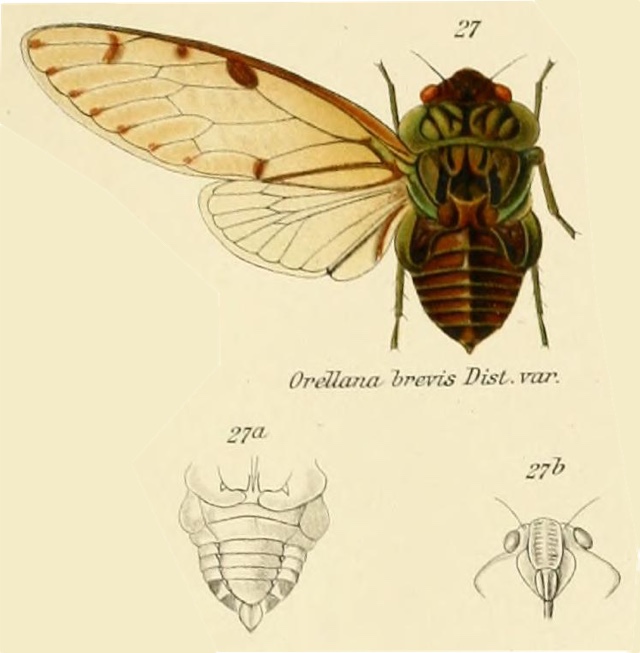
The image says Orellana brevis, but the newest name of this cicada is Zammara brevis.
Zammara genus description by W. L. Distant from Genera Insectorum, 1914:
Characters. — Head (including eyes) about as wide as base of mesonotum, ocelli farther removed from eyes than from each other, eyes prominent but scarcely projecting beyond the anterior pronotal angles, vertex strongly depressed before base of front; face longer than broad, narrowly sulcate; pronotum shorter than mesonotum, the lateral margins angularly ampliate; mesonotum about as long as head and pronotum together; metanotum exposed; abdomen short; tympanal coverings outwardly complete, the orifices very widely exposed internally; opercula short, oblique; rostrum reaching or slightly passing the posterior coxae; tegmina usually three times as long as broad, apical areas eight; wings with six apical areas.
Uhleroides cubensis Distant, 1912 is a cicada found in Cuba.
Scientific classification:
Family: Cicadidae
Subfamily: Cicadinae
Tribe: Zammarini
Genus: Uhleroides
Species: Uhleroides cubensis Distant, 1912
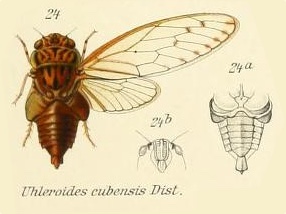
Uhleroides genus description by W. L. Distant:
Characters. — Head slightly shorter than pronotum, front considerably shorter than vertex, lateral margins of both nearly continuous and both centrally, longitudinally finely Silicate; ocelli a little farther apart from eyes than from each other, vertex impressed between ocelli and eyes, the latter scarcely projecting beyond the anterior pronotal angles; pronotum shorter than mesonotum. the lateral margins moderately ampliate but not angulate; mesonotum shorter than head and pronotum together; abdomen about as long as space between apex of head and base of cruciform elevation; tympanal coverings globose and projecting beyond the lateral margins of the abdomen, outwardly complete, the orifices only exposed inwardly; opercula not extending beyond base of abdomen, lateral and apically rounded, not meeting internally; rostrum reaching the posterior coxae; face longer than broad, lateral margins a little sinuate near base, finely centrally sulcate on posterior half, strongly transverse^ striate, the lateral margins a little broadly reflexed; tegmina three times as long as broad, hyaline, eight apical areas, basal eel! longer than broad; wings about half as long as tegmina, six apical areas; anterior femora armed with two spines beneath.
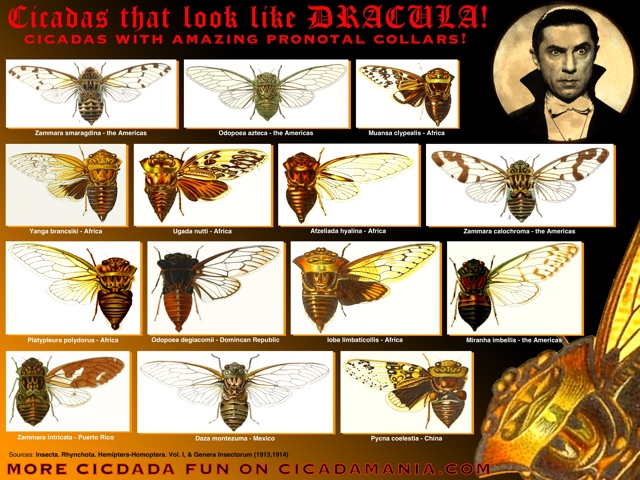
Halloween is almost here, and so I created something special for that time of year: a poster of cicadas with pronotal collars that look like Dracula’s collar — or at least Bela Lugosi’s Dracula. Or maybe Dr. Strange?
Download the large 1.4MB version.
The image features the cicada’s species name and where it can be found. To save space, I went with the continent(s) in when the cicada is found in multiple nations or continents.
The images of cicadas come from the Genera Insectorum 1913, Genera Insectorum 1914, and Insecta. Rhynchota. Hemiptera-Homoptera. Vol. I (1881-1905). Old but classic and important documents with plenty of awesome cicada illustrations.
Happy Halloween!!
Miranha imbellis (Walker, 1858) can be found in Mexico and Central America.
Miranha imbellis is a member of the Zammarini tribe of cicadas, known for their Dracula/Vampire-style pronotal collars. One way to sort the M. imbellis from other members of this tribe is the infuscations (dark colorations) on its wings are relatively pale compared to Zammara cicadas, but not absent like the Odopoea azteca or Daza montezuma, and more obvious than Odopoea degiacomii. See this page to compare.
Scientific classification:
Family: Cicadidae
Subfamily: Cicadinae
Tribe: Zammarini
Genus: Miranha
Species: Miranha imbellis (Walker, 1858)
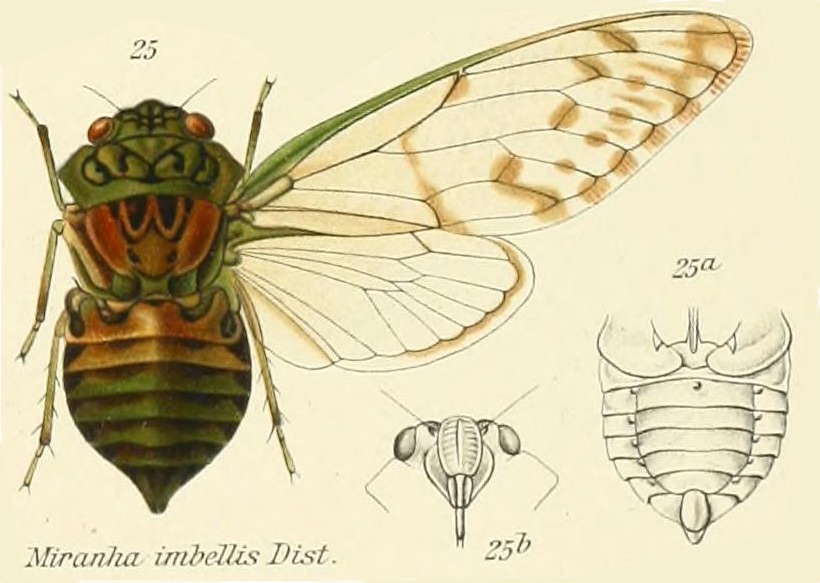
Miranha genus description by W. L. Distant:
Characters. — Head (including eves) a little narrower than base of mesonotum. the front moderately prominent, but only about half the length of vertex, lateral margins of vertex a little convex; pronotum about as long as mesonotum, its lateral margins ampliate and medially angulate ; abdomen about as long as space between apex of head and base of cruciform elevation, its lateral areas above moderately oblique, the tympanal orifices inwardly covered but outwardly exposed; abdomen beneath with the disk oblique on each side, but with the lateral margins broadly subreflected ; rostrum passing the posterior coxÅ“; opercula small, transverse; tarsi three-jointed ; tegmina and wings hyaline, the first with eight apical areas, and the basal cell considerably longer than broad.
Odopoea degiacomii Distant, 1912, was described by British entomologist W. L. Distant in 1812.
Odopoea degiacomii is a visually impressive cicada with a prominent pronotal collar that should inspire thoughts of Dracula the Vampire (like other members of the cicada tribe Zammarini). It won’t suck your blood, but it will suck xylem sap from trees.
This cicada is found in the Dominican Republic and probably Haiti.
Scientific classification:
Family: Cicadidae
Sub Family: Cicadinae
Tribe: Zammarini
Genus: Odopoea
Species: Odopoea degiacomii Distant, 1912
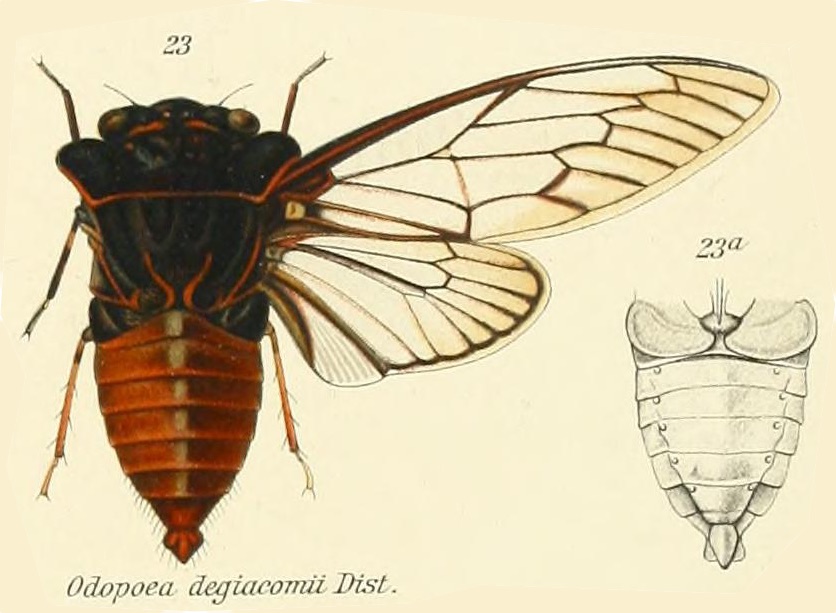
An Odopoea degiacomii Stål genus description by W. L. Distant from Genera Insectorum:
Characters. — Head (including eyes) about equal in width t.. base of mesonotum, ocelli a little wider apart from eyes than from each other, eyes prominent, a little passing the anterior pronotal angles; face more or less longitudinally sulcate; rostrum about reaching the posterior cox*; pronotum shorter than mesonotum, the lateral margins angularly ampliate; mesonotum (including basal cruciform elevation) almost as long as head and pronotum together; abdomen broad, centrally ridged, the lateral areas more or less oblique, about as long as space between apex of head and base of cruciform elevation; operçula short, broad, not extending beyond base of abdomen; tympanal coverings outwardly complete, the orifices only exposed inwardly; tegmina three or more than three times as long as broad, apical areas eight; wings with six apical areas.
Zammara intricata Walker, 1850 (in case you’re wondering “Walker” is the person who first described this cicada, and 1850 was the year he described it) is another beautiful cicada belonging to the Zammara genus. Zammara cicadas are known for their prominent pronotal collars that inspire thoughts of Dracula the vampire, their brilliant green to turquoise colors, and infuscation (the dark areas) on their wings. Zammara intricata has a lot of infuscation in their wings, even for a Zammara. Intricata means “complex”, which might be a reference to the complexity of the infuscation.
It is found in Puerto Rico.
Scientific classification:
Family: Cicadidae
Sub Family: Cicadinae
Tribe: Zammarini
Genus: Zammara
Species: Zammara intricata Walker, 1850
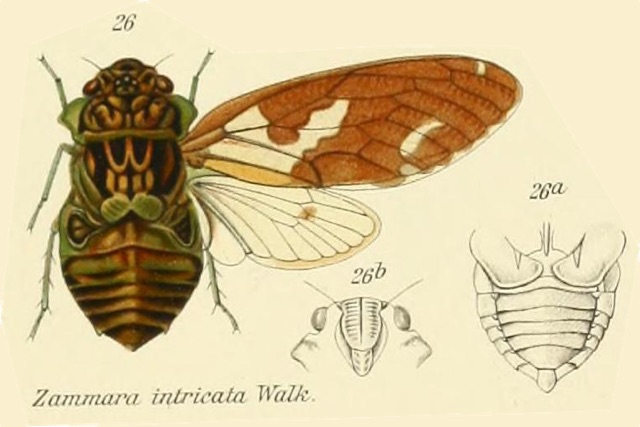
Zammara Amyot & Serville genus description by W. L. Distant:
Characters. — Head (including eyes) about as wide as base of mesonotum, ocelli farther removed from eyes than from each other, eyes prominent but scarcely projecting beyond the anterior pronotal angles, vertex strongly depressed before base of front; face longer than broad, narrowly sulcate; pronotum shorter than mesonotum, the lateral margins angularly ampliate; mesonotum about as long as head and pronotum together; metanotum exposed; abdomen short; tympanal coverings outwardly complete, the orifices very widely exposed internall} – ; opercula short, oblique; rostrum reaching or slightly passing the posterior coxae; tegmina usually three times as long as broad, apical areas eight; wings with six apical areas.
Most of the information on this website is focused on cicadas of the U.S.A. and Canada. There are plenty of cicadas south of the U.S., of course. Recently we started getting identification (ID) requests for cicadas of Mexico, and with the help of experts (Geert Goemans and Allen Sanborn) and a paper from the early 20th century, I was able to ID them all.
A large number of the IDs were for cicadas with pronounced pronotal collars. Many of these look like the same species, but they’re not. Many of these species are found from Mexico, throughout Central America down to South America.
On this page are six collared cicadas that exist in Mexico, Central America and South America. Illustrations come from Insecta. Rhynchota. Hemiptera-Homoptera. Vol. I by W. L. Distant and The Rev Canon W. W. Fowler, F.L.S. I updated the names to their current names (the source is about 100 years behind the times, expectedly so). Note that the illustrations from this document are of dead specimens, so the colors were faded at the time they were illustrated.
Formerly Odopoea montezuma. This cicada is actually tourquois to pale blue when alive. Red eyes. No infuscation (coloration) in the wings. Link to original illustration..
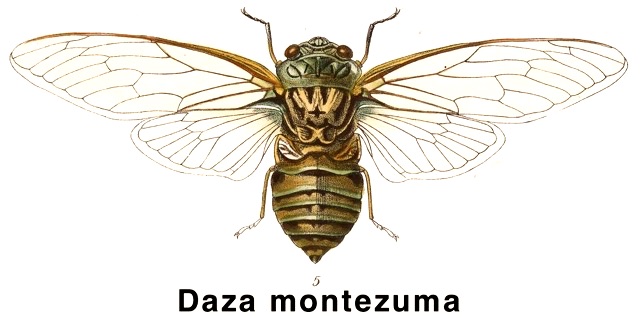
Green with black infuscation in the wings.
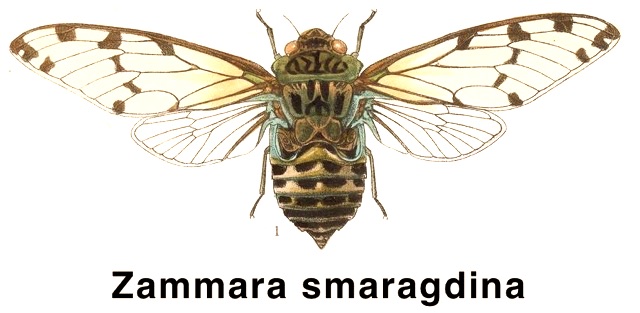
Here is a photo by Andreas Key (taken in Ecuador):
Green with remarkable black infuscation in the wings.
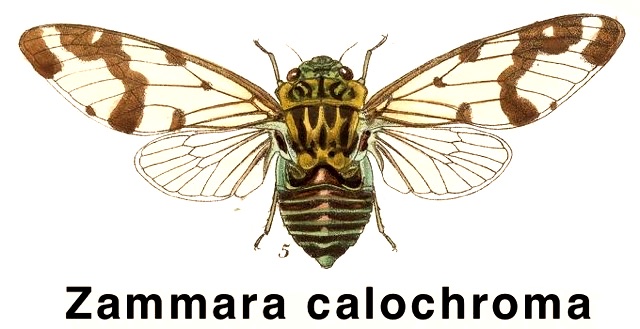
formerly Odopoea imbellis
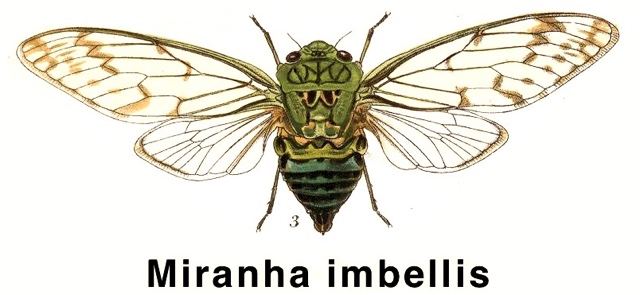
formerly Odopoea medea
